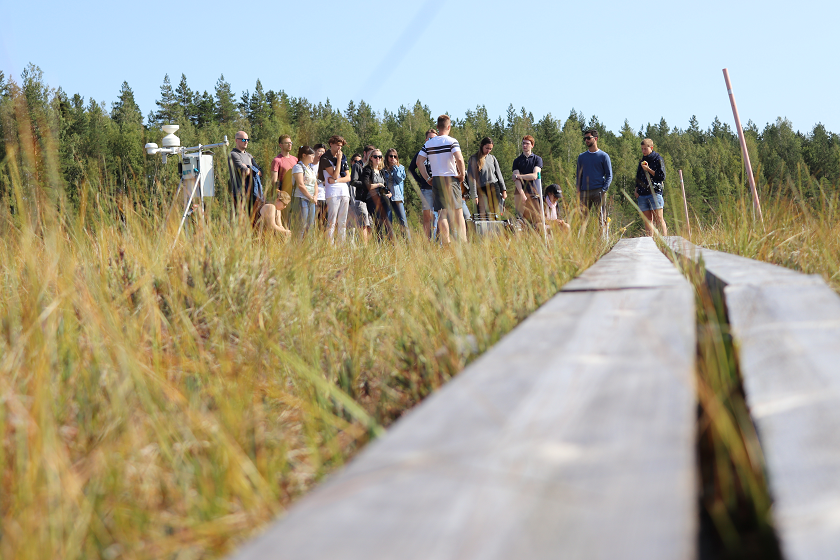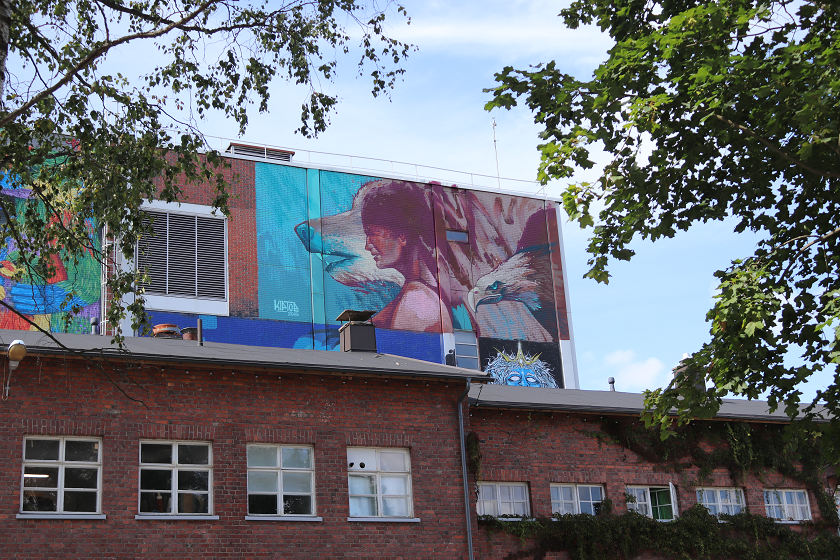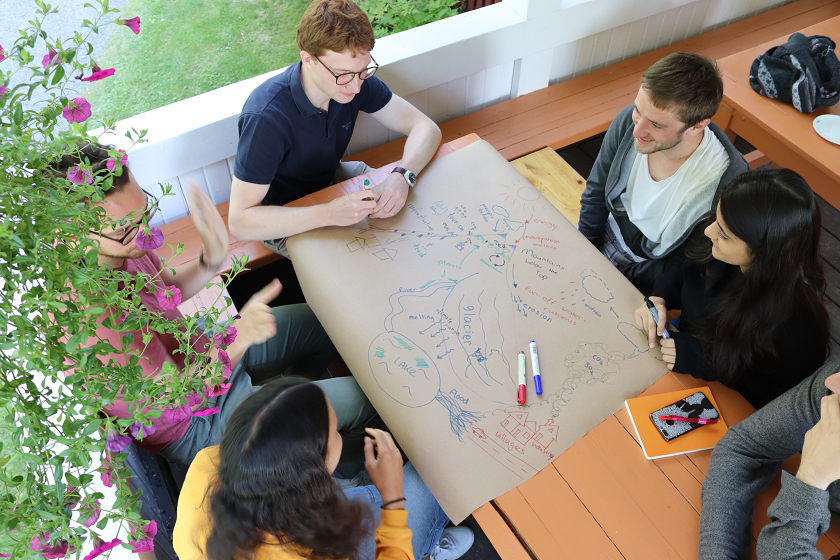The Northern Path – Journey summer school exploring Finland
In The News
15 Aug 2019
A new set of change makers set out on their climate innovation path at the start of August, marking the beginning of the final courses on this tenth edition of the EIT Climate-KIC Journey summer school. On the first week of their Journey, the Northern Path explored the impact of climate change on various ecosystems and cities in the midst of Finnish nature.
Located 220 km North-West of Helsinki, 60 km North-East of Tampere, Hyytiälä Forestry Field Station served as the first location of the Northern Path Journey. Here, cutting edge science and long traditions meet in the middle of the boreal forest in the station managed by the University of Helsinki.
International and multidisciplinary research is carried out at the field station on topics ranging from forest sciences and peatland ecology to atmospheric processes at the SMEAR II station.
“The University of Helsinki is hosting the Climate Journey for the very first time and we have brought the Journey students to the heart of atmospheric sciences here in Hyytiälä”
said Laura Riuttanen, Postdoctoral Researcher and Journey 2019 Manager at the University of Helsinki. “The multidisciplinary measurements conducted here illustrate the complexity of climate sciences, and I hope the visit will demonstrate the importance of collaboration to the students in order to manage issues related to climate change” she continued.
Changes unnoticed to the naked eye
The Northern Path participants represent a number of nationalities and backgrounds ranging from economics and business to climate sciences and engineering, all coming together for one goal – to tackle climate change.
During their first days at the Journey, the particpants gained information on the basics of climate change and explored the effect climate change has on various ecosystems. This exploration included field visits to the SMEAR II station, where continuous research is carried out on the interaction between land ecosystems and the atmosphere and to nearby Siikaneva, where scientists are carrying out research on peatland ecosystems.
In Finland, over 70% of the land surface is covered by forest and the country also boasts a staggering number of almost 200,000 lakes. While Hyytiälä is surrounded by picturesque nature and some of the cleanest air in the world, change is still taking place mostly unnoticed to the naked eye.
“You cannot see it, but by the machinery and the data that they’re analysing here for the last 25 years, they can see the difference. This is very valuable information so we know that we don’t need to see it for the changes to happen”
said Miguel, a Climate Journey Participant from Portugal.

Cities working strategically with sustainability
In addition to focussing on natural environments and the research carried out in the field, the Northern Path also explored the interrelations between climate change and cities.
The urban population is growing rapidly across the globe. In addition, cities are the engines of economic growth, they have vast concentrations of infrastructure and cities are spaces for almost 80% of the global end energy use. Livable and sustainable cities are vital to global well-being and cities can’t be seen as independently operating entities – they are both connected to the surrounding areas and other cities and countries in the world.
To learn how cities can work strategically and tangibly with sustainability, the Northern Path went on a fieldtrip to Tampere, a city that has set out to be carbon-neutral by 2030. In order to achieve this target, Tampere will reduce 80% of its CO2 emissions compared to the levels in 1990 and compensate the rest by increasing the amount of carbon sinks in the area. Through its strategic development initiative, the Smart City Tampere Programme, the city aims to build a sustainable and smart Tampere region.
One such area is Hiedanranta – a smart and sustainable city district of the future. The area serves as a test bed for new ideas, projects and nature based solutions and is a true demonstration of a a growing and flourishing urban city culture. Here, the City of Tampere introduced their plans for transforming the area into a livable, smart and sustainable residential district in cooperation with the local residents, various businesses and the community.

Importance of systems thinking in finding solutions
A new element to the Journey summer schools this year has been to introduce a stronger focus on the element of systems thinking into the programme. In order to create the fast paced, transformational changes needed to tackle climate change, it is not enough anymore to target single point solutions. Instead, there is a need to focus on systemic and deepgoing transformation and wider collaboration.
While systems thinking and systems innovation can be a challenging process, it allows the Journey participants to explore visions of the future and the boundaries of these visions. In the end, the Journey is is about equipping the participants to go out into the world after the Joruney and their studies to explore, learn and sense-make beyond the known and proven concepts to find the solutions of tomorrow.
According to Rutger, a Climate Journey Participant from the Netherlands, you can compare what climate change is all about to a camera. If you would only have the body or the lense of a camera, you couldn’t take a picture. Instead,
“You need to connect all the different aspects that relate to the climate system in order to understand what is going on. It’s very complex and we still don’t know what it is, but I think its very good that we’re encouraged to think in systems because without that you’re bound to fail”.
“It’s the way you find the right solutions”
Nik, a fellow Climate Journey Participant from Germany, concludes.

University collaboration in hosting the Journey
During the weekend, The Northern Path continued their journey to Espoo and Helsinki where they explored their systems maps and trajectories for the coming weeks. Hosted by Aalto University at their Otaniemi campus, the participants are also learning about the start-up and entrepreneurial scene in Finland.
”Aalto has hosted the Climate-KIC summer school for several years and the focus here has always been on entrepreneurship. This year, we hosted the Journey together with the University of Helsinki and the experience has been very positive, both for the students and the two universities.”
said Petri Allekotte, Project Manager EIT Climate-KIC, Aalto University.
“Aalto’s aim is to strengthen international cooperation and student mobility between European universities in its educational offering, and the Journey supports this aim extremely well. In addition, we believe that Aalto University has once again gained a bit more interest in the eyes of European students” he continued.
It is here at Aalto University where the students have looked at their own interests, skills and knowledge in the initial phases of mapping out what projects and solutions they will start working on during the last weeks of the Journey. The self-exploration and sharing of these insights with the other participants is an important step in forming the teams and project visions, as these will become the core of the climate solutions the participants will pitch at the Community Summit in Budapest at the end of August.
Want to keep following the journey of the Northern Path? Have a look at our social media channels and follow #ClimateJourney on the various platforms. For pictures from the first week of the Journey, visit the link below!
Northern Path in Finland




